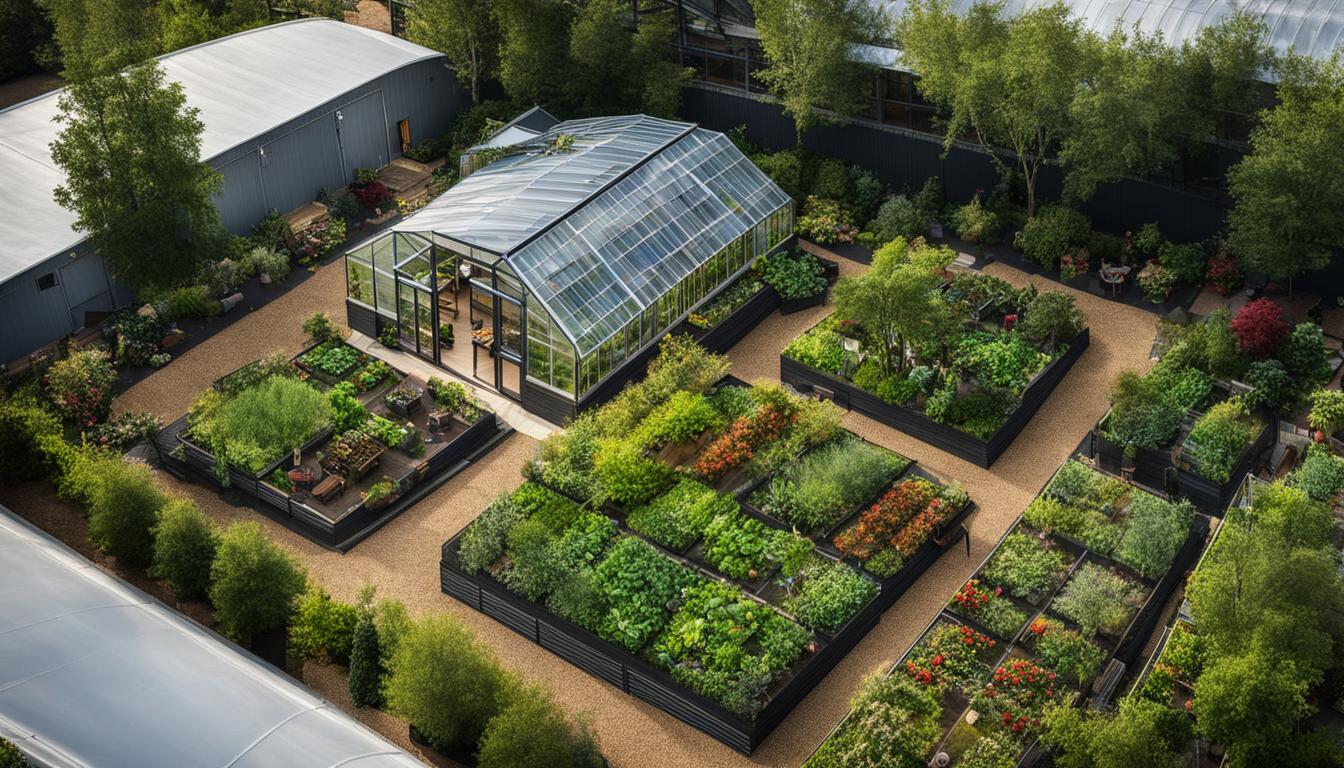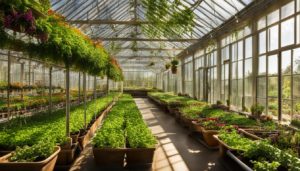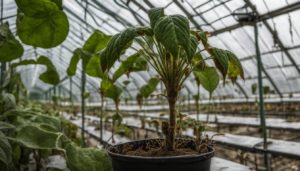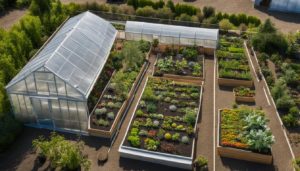Selecting the best location for your greenhouse is crucial for its success. The right placement can maximize sunlight exposure and optimize growth. Here’s what you need to consider when deciding where to put your greenhouse.
Key Takeaways:
- Choose a location that provides ample sunlight for your greenhouse.
- Protect your greenhouse from harsh winds and frost pockets.
- Consider the orientation of your greenhouse for year-round or seasonal use.
- Avoid placing your greenhouse under tall trees to prevent shade and potential damage.
- Ensure convenient accessibility for maintenance and amenities like water and electricity.
Assessing Your Garden’s Conditions
When choosing the location for your greenhouse, it is essential to assess the unique conditions of your garden. Consider factors such as the micro-climate, sunlight exposure, wind protection, frost pockets, and drainage. By carefully evaluating these elements, you can ensure that your greenhouse thrives in its chosen spot.
The micro-climate of your garden refers to the specific weather conditions and climate patterns that occur within it. Take note of areas that receive ample sunlight throughout the day, as well as natural daylight. These spots are ideal for locating your greenhouse, as they provide the necessary light for optimal plant growth.
Furthermore, it is important to select a location that offers protection from harsh winds. Look for areas that are sheltered by natural windbreaks, such as fences or existing structures. By shielding your greenhouse from strong winds, you can prevent damage to delicate plants and maintain a more stable internal environment.
In addition to wind protection, you should also consider the presence of frost pockets in your garden. Frost pockets are low-lying areas where cold air accumulates and can cause damage to plants. Avoid placing your greenhouse in these areas to prevent frost damage and ensure the overall health of your plants.
Lastly, good drainage is crucial for the success of your greenhouse. Avoid areas with poor drainage or excessive dampness, as this can lead to waterlogging and root rot. Opt for a level ground with well-draining soil or consider using raised beds or containers as alternatives.
| Factors to Consider | Location Requirements |
|---|---|
| Sunlight Exposure | Choose areas that receive ample sunlight and natural daylight |
| Wind Protection | Look for locations sheltered from harsh winds using natural windbreaks |
| Frost Pockets | Avoid placing the greenhouse in low-lying areas prone to frost |
| Drainage | Select a location with good soil drainage to prevent waterlogging |
Considering Orientation
When planning the location of your greenhouse, it’s important to consider the orientation and alignment for optimal year-round growth. The positioning of the ridge of the roof plays a crucial role in maximizing light and ensuring equal sunlight distribution inside the greenhouse.
East-West Ridge for Year-Round Growth
If you intend to use your greenhouse throughout the year, aligning the ridge of the roof in an east-west direction is recommended. This orientation allows your greenhouse to capture the maximum amount of sunlight during the darkest months, providing ample light for your plants’ growth.
North-South Ridge for Seasonal Use
If you plan to use your greenhouse primarily in spring and summer, a north-south ridge alignment is ideal. This orientation ensures that both sides of the greenhouse receive equal sunlight throughout the day. By optimizing sunlight exposure, your plants can thrive and reach their full potential.
Additionally, if you have a lean-to greenhouse, it is best to have the supporting wall on the north side and face the greenhouse southwards. This arrangement allows for better utilization of sunlight and ensures that your plants receive adequate light for their growth.
By considering the orientation of your greenhouse, you can create an environment that maximizes light intake and promotes optimal growth for your plants throughout the year.
| Orientation | Advantages |
|---|---|
| East-West Ridge | Maximizes sunlight during the darkest months for year-round growth |
| North-South Ridge | Provides equal sunlight distribution for seasonal use |
Avoiding Obstructions
When selecting the location of your greenhouse, it’s important to consider potential obstructions that can affect its performance. Here are some key factors to keep in mind:
Shade
One of the main obstructions to be mindful of is shade. Avoid placing your greenhouse directly underneath tall trees or structures that can cast shadows and block sunlight. Without sufficient sunlight, your plants may struggle to photosynthesize and thrive. It’s best to choose a location that receives ample sunlight throughout the day to ensure optimal growth.
Tree Branches
Additionally, be cautious of the proximity of tree branches to your greenhouse. If there are overhanging branches, they can pose a risk of falling and causing damage to the structure. Trim any branches that may potentially come into contact with your greenhouse to prevent accidents and maintain the integrity of the structure.
Windbreak and Wind Chill Factor
Another aspect to consider is the windbreak and wind chill factor. While you want your greenhouse to be protected from harsh winds, it’s important to strike a balance. Strategically using high walls, tall hedges, or trees can act as windbreaks and provide shelter without obstructing sunlight. However, be cautious of creating an environment where cold air becomes trapped, leading to freezing temperatures inside the greenhouse. Proper ventilation and insulation can help mitigate the adverse effects of wind chill.
| Obstruction | Impact | Prevention Measures |
|---|---|---|
| Shade from trees or structures | Reduced sunlight and hindered plant growth | Choose a location with ample sunlight and avoid placing the greenhouse directly under shade-causing obstructions |
| Overhanging tree branches | Risk of branch damage and potential harm to the greenhouse | Trim branches that pose a risk to prevent damage and accidents |
| Windbreak | Protects against strong winds | Strategically use high walls, tall hedges, or trees as windbreaks without obstructing sunlight |
| Wind chill factor | Potential freezing temperatures inside the greenhouse | Ensure proper ventilation and insulation to mitigate the impact of wind chill |
Ensuring Accessibility and Convenience
When selecting the location of your greenhouse, it’s important to consider accessibility and convenience. Placing your greenhouse in a convenient location will make it easier for you to maintain and use. Here are a few factors to keep in mind:
Proximity to the House
Having your greenhouse located close to your house offers many benefits. It provides easy access to amenities such as a water tap and mains electricity, which are essential for maintaining your greenhouse efficiently. Additionally, being near the house makes it convenient to collect rainwater from the greenhouse’s gutters, which can be used to water your plants.
Insulation
Insulation is crucial for maintaining stable temperatures inside your greenhouse. If your greenhouse is located far from the house and amenities are not easily accessible, you can use alternative options for insulation. Consider using paraffin heaters or insulated fleece to mitigate temperature changes and protect your plants from extreme cold or heat.
Proximity to the Kitchen
If you plan to use your greenhouse for growing fresh produce, it’s beneficial to have it located close to your kitchen. This allows for easy access to your harvest, making it more convenient for cooking and enjoying homegrown meals.
By considering these factors, you can ensure that your greenhouse is conveniently located and easily accessible, making it a pleasure to use and maintain.
Conclusion
Choosing the optimal location for your greenhouse is essential for maximizing productivity and growth. By carefully considering the unique conditions of your yard, such as sunlight exposure, wind protection, and accessibility to amenities, you can create an ideal environment for your plants.
Assessing the orientation options based on your intended usage of the greenhouse is also crucial. Whether you’re aiming for year-round growth or seasonal use, selecting the right ridge alignment can ensure that your plants receive the optimal amount of sunlight.
Avoiding obstructions such as tall trees that can block sunlight and potentially cause damage is also important. Instead, strategically utilize windbreaks like high walls or tall hedges to provide shelter without compromising light exposure.
Lastly, prioritize convenience and proximity to the house for easy access and maintenance. Choosing a location near amenities like a water tap and mains electricity can enhance your greenhouse gardening experience. By carefully considering these factors and selecting the optimal greenhouse location, you can unleash your green thumb and enjoy bountiful harvests.
FAQ
Why is selecting the best location for a greenhouse important?
Selecting the best location for your greenhouse is crucial for its success as it maximizes sunlight exposure and protects it from harsh winds and frost pockets, providing optimal growing conditions.
What factors should I consider when assessing my garden’s conditions for a greenhouse?
Consider factors such as the micro-climate, sunlight exposure, wind protection, and the presence of frost pockets and good drainage to ensure your greenhouse thrives in the right conditions.
How does the orientation of a greenhouse affect its functionality?
The orientation of a greenhouse can impact its functionality. For year-round growth, an east-west ridge alignment maximizes light during the darkest months, while a north-south alignment ensures equal sunlight for seasonal use.
Should I avoid placing my greenhouse under tall trees?
Yes, it is advisable to avoid placing your greenhouse directly underneath tall trees as they can cast shade, reducing light exposure, and potentially causing damage from falling branches. However, using trees or tall hedges strategically as windbreaks can be beneficial.
What amenities should I consider when selecting the location of my greenhouse?
Consider amenities such as a water tap and mains electricity for convenience. Placing the greenhouse closer to the house ensures easy access and convenient collection of rainwater from the gutters. Alternative options can be used if proximity to amenities is not possible.
Why is optimal greenhouse location important for productivity and growth?
Selecting the ideal location for your greenhouse maximizes productivity and growth by providing the right conditions for plants to thrive, ensuring ample sunlight, wind protection, and easy accessibility for maintenance and care.




